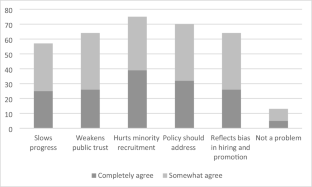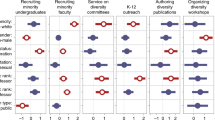Abstract
Universities and research institutes increasingly emphasize diversity in hiring scientists. The organizational practice of considering personal characteristics of scientists seemingly conflicts with an institutional norm of universalism in which rewards are allocated according to pre-established impersonal criteria. How do scientists view the relationship between merit and diversity in hiring? This study addresses this question through an analysis of in-depth interviews with 119 physicists and biologists in the US, the United Kingdom, India, and Italy. The results point to three broad patterns. First, most scientists regard insufficient diversity in science as a problem but not all view personal characteristics as critical to appointment processes. Second, organizational diversity initiatives generate adverse effects for underrepresented scientists and research organizations. Finally, some scientists argue that the notion of merit should be reframed to consider personal characteristics of scientists. Such patterns demonstrate how competing goals of organizational and institutional reward systems generate normative conflict in science.

Similar content being viewed by others
Notes
Scientists in India (South Asian) and Italy (White) are more likely to espouse this view.
P-SV-DJ-18-IN-3265.
B-SV-BN-05-IT-6995.
B-SV-CK-06-US-19391.
B-SV-CS-04-IT-6909.
B-SV-BR-14-UK-13321.
B-SV-DJ-02-US-19169.
P-SB-BN-10-IT.
P-SV-PP-03-IN-3818.
B-SV-NS-25-US-20143.
B-SV-DJ-11-US-19221.
P-SV-CS-03-IT-11523.
B-SV-OR-05-US-18887.
P-SV-CK-16-US-21441. Race indicated as “Other” on the survey.
B-SB-BR-16-US.
B-SV-BR-23-US-19204.
B-SB-NS-12-UK.
B-SV-AU-11-UK-12317.
B-SV-DJ-12-UK-13264.
P-SV-CK-03-UK-17600.
B-SV-BV-08-US-18680.
P-SV-AU-02-UK-18221.
P-SV-NS-21–16,506.
P-SV-NS-21–16,506.
B-SV-NS-22-UK-12297.
B-SV-OR-03-US-20610.
References
Blair-Loy, M., & Cech, E. A. (2022). Misconceiving merit: Paradoxes of excellence and devotion in academic science and engineering. Chicago, IL: University of Chicago Press.
Bourdieu, P. (1988). Homo Academicus. Palo Alto, CA: Stanford University Press.
Cole, S., Cole, J. R., & Simon, G. A. (1981). Chance and consensus in peer review. Science, 214(4523), 881–886.
De Angelis, G., & Grüning, B. (2020). Gender inequality in precarious academic work: Female adjunct professors in Italy. Frontiers in Sociology, 4, 87. https://doi.org/10.3389/fsoc.2019.00087
Devine, P. G., Forscher, P. S., & Cox, W. T. (2017). A gender bias habit-breaking intervention led to increased hiring of female faculty in STEMM departments. Journal of Experimental Social Psychology, 73, 211–215. https://doi.org/10.1016/j.jesp.2017.07.002
Dobbin, F., Schrage, D., & Kalev, A. (2015). Rage against the iron cage: The varied effects of bureaucratic personnel reforms on diversity. American Sociological Review, 80(5), 1014–1044.
Etzkowitz, H. (1989). Entrepreneurial science in the academy: A case of the transformation of norms. Social Problems, 36(1), 14–29.
Feder, T. (2024). State anti-DEI laws sow uncertainty in public colleges and universities. Physics Today, 77(4), 22–25.
Finkelstein, M. J., Conley, V. M., & Schuster, J. H. (2016). The faculty factor: Reassessing the American academy in a turbulent era. Baltimore, MD: Johns Hopkins University Press.
Garcia, G., Koren, E., & Cuellar, M. (2020). Assessing color-neutral racial attitudes of faculty at Hispanic-serving institutions. AERA Open, 6(3), 1–14.
Gasman, M., Kim, J., & Nguyen, T.-H. (2011). Effectively recruiting faculty of color at highly selective institutions: A school of education case study. Journal of Diversity in Higher Education, 4, 212–222.
Gieryn, T. F. (2022). Cultural boundaries of science: Credibility on the line. Chicago, IL: University of Chicago Press.
Guetzkow, J., Lamont, M., & Mallard, G. (2004). What is originality in the humanities and the social sciences? American Sociological Review, 69(2), 190–212.
Gurin, P., Dey, E., Hurtado, S., & Gurin, G. (2002). Diversity and higher education: Theory and impact on educational outcomes. Harvard Educational Review, 72(3), 330–367.
Hadley, C. R. (2023). Small Campus, Big Issues: Leading the new diversity, equity, and inclusion committee. Journal of Cases in Educational Leadership, 27(2), 19–35.
Hamilton, L. T., & Nielsen, K. (2021). Broke: The racial consequences of underfunding public universities. Chicago, IL: University of Chicago Press.
Hermanowicz, J. C. (2019). The degradation of merit. Society, 56(4), 340–347.
Jehn, K., Northcraft, B., & Neale, M. (1999). Why differences make a difference: A field study of diversity, conflict, and performance in workgroups. Administrative Science Quarterly, 44, 741–763.
Johnson, D. R. (2017). A fractured profession: Commercialism and conflict in academic science. Johns Hopkins University Press.
Johnson, D. R., & Hermanowicz, J. C. (2017). Peer review: From “sacred ideals” to “profane realities”. In Higher education: Handbook of theory and research (pp. 485–527). Cham, Switzerland: Springer.
Kalev, A., Dobbin, F., & Kelly, E. (2006). Best practices or best guesses? Assessing the efficacy of corporate affirmative action and diversity policies. American Sociological Review, 71(4), 589–617.
Kelly, B. T., Gayles, J. G., & Williams, C. D. (2017). Recruitment without retention: A critical case of Black faculty unrest. Journal of Negro Education, 86, 305–317.
Knights, D., & Richards, W. (2003). Sex discrimination in UK academia. Gender, Work & Organization, 10(2), 213–238.
Kurup, A., & Raj, A. (2022). Changing patterns of work–life balance of women scientists and engineers in India. Science, Technology and Society, 27(4), 485–501.
Lawrence, T., Suddaby, R., & Leca, B. (2011). Institutional work: Refocusing institutional studies of organization. Journal of Management Inquiry, 20(1), 52–58.
Leong, N. (2021). Identity capitalists: The powerful insiders who exploit diversity to maintain inequality. Palo Alto, CA: Stanford University Press.
Liera, R. (2020). Equity advocates using equity-mindedness to interrupt faculty hiring’s racial structure. Teachers College Record, 122(9), 1–42.
Loder, N. (1999). Gender discrimination ‘undermines science.’ Nature, 402(6760), 337–337.
Long, J. S., & Fox, M. F. (1995). Scientific careers: Universalism and particularism. Annual Review of Sociology, 21(1), 45–71.
MacArthur, B. (2021). Truth and beauty in physics and biology. Nature Physics, 17(2), 149–151.
Merton, R. K. (1973). The sociology of science: Theoretical and empirical investigations. Chicago, IL: University of Chicago Press.
Mitroff, I. I. (1974). Norms and counter-norms in a select group of the Apollo moon scientists: A case study of the ambivalence of scientists. American Sociological Review, 39(4), 579–595.
National Science Board, National Science Foundation. (2019). Science and engineering indicators 2020: Science and Engineering Labor Force. Science and Engineering Indicators 2020. NSB-2019–8. Alexandria, VA. Available at https://ncses.nsf.gov/pubs/nsb20198/. Accessed 15 Jan 2023.
Need, A. C., & Goldstein, D. B. (2009). Next generation disparities in human genomics: Concerns and remedies. Trends in Genetics, 25(11), 489–494.
Park, J. J., & Denson, N. (2009). Attitudes and advocacy: Understanding faculty views on racial/ethnic diversity. The Journal of Higher Education, 80(4), 415–438.
Posselt, J. R. (2014). Toward inclusive excellence in graduate education: Constructing merit and diversity in PhD Admissions. American Journal of Education, 120(4), 481–514.
Posselt, J. (2016). Inside graduate admissions: Merit, diversity, and faculty gatekeeping. Cambridge, MA: Harvard University Press.
Price, M. (2020). Diversity statements divide mathematicians. Science, 367(6475), 239.
Purdie-Vaughns, V., Steele, C. M., Davies, P. G., Ditlmann, R., & Crosby, J. R. (2008). Social identity contingencies: How diversity cues signal threat or safety for African Americans in mainstream institutions. Journal of Personality and Social Psychology, 94(4), 615.
Rhoades, G. (2014). The higher education we choose, collectively: Reembodying and repoliticizing choice. The Journal of Higher Education, 85(6), 917–930.
Smith, D. G., Turner, C. S. V., Osei-Kofi, N., & Richards, S. (2004). Interrupting the unusual: Successful strategies for hiring diverse faculty. Journal of Higher Education, 75, 133–160.
Stevens, M. L. (2009) Creating a class: College admissions and the education of elites. Cambridge, MA: Harvard University Press.
Stevens, M. L., & Roksa, J. (2011). The diversity imperative in elite admissions. In L. M. Stulberg & S. L. Weinberg (Eds.), Diversity in American higher education: Toward a more comprehensive approach (pp. 63–73). Routledge.
Stone, J., Pinn, V. W., Rudick, J., Lawrence, M., & Carlyn, M. (2006). Evaluation of the first 10 years of the Office of Research on Women’s Health at the National Institutes of Health: Selected findings. Journal of Women’s Health, 15(3), 234–247.
Strauss, A., & Corbin, J. (1990). Basics of qualitative research: Techniques and procedures for developing grounded theory. New York, NY: Sage Publications.
van Dijk, H., Kooij, D., Karanika-Murray, M., De Vos, A., & Meyer, B. (2020). Meritocracy a myth? A multilevel perspective of how social inequality accumulates through work. Organizational Psychology Review, 10(3–4), 240–269.
White-Lewis, D. K. (2020). The facade of fit in faculty search processes. The Journal of Higher Education, 91(6), 833–857.
World Bank. (2021). Research and development expenditure (% of GDP). UNESCO Institute for Statistics. https://data.worldbank.org/indicator/GB.XPD.RSDV.GD.ZS
Zuckerman, H., & Merton, R. K. (1971). Patterns of evaluation in science: Institutionalisation, structure and functions of the referee system. Minerva, 66–100.
Author information
Authors and Affiliations
Corresponding author
Additional information
Publisher's Note
Springer Nature remains neutral with regard to jurisdictional claims in published maps and institutional affiliations.
Rights and permissions
Springer Nature or its licensor (e.g. a society or other partner) holds exclusive rights to this article under a publishing agreement with the author(s) or other rightsholder(s); author self-archiving of the accepted manuscript version of this article is solely governed by the terms of such publishing agreement and applicable law.
About this article
Cite this article
Johnson, D.R., Vaidyanathan, B. Open to talent? How scientists assess merit and diversity in hiring. High Educ (2024). https://doi.org/10.1007/s10734-024-01244-8
Accepted:
Published:
DOI: https://doi.org/10.1007/s10734-024-01244-8




